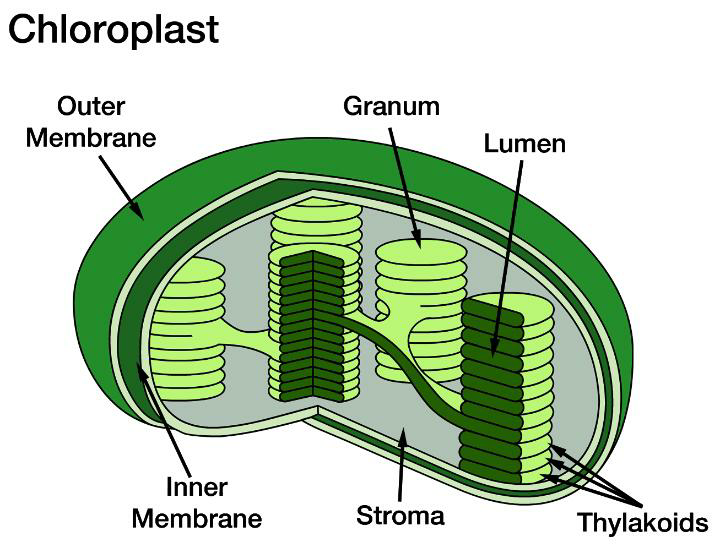
Answer
439.5k+ views
Hint: Plastids are double membrane-bound organelles found only in plants. Their main function is procuring and storing food inside the cell which can be used up by the cell in conditions of stress. The plastids which help in the process of photosynthesis are composed of photosynthetic pigments that drive the photosystem to trap the sunlight which is essential for making food.
Complete answer: The type of plastids that help in photosynthesis is called a chloroplast. These plastids contain pigment such as chlorophyll a and b that absorb blue and red light. This light energy is then transduced to a chemical compound called glucose, which is stored as starch.

Chloroplasts are highly abundant plastids present in plants. They are responsible for carrying out the major process of food preparation via photosynthesis. These are present in the form of disc-shaped organelles within a plant cell, which allows plants to capture the solar energy. Chloroplasts are surrounded by two membranes, which means that they are bi-layered. The layers are made up of phospholipids. Photosynthesis occurs in two phases; light-dependent and light-independent. Energy molecules are synthesized in light-dependent reactions, whereas fixation of carbon dioxide takes place in light-independent reactions.
Note: Chloroplasts are composed of various organelles that are imperative to perform photosynthesis. These include stroma and lamellae which are further arranged as granum and lumen. It contains chlorophyll which acts as the reaction centre.
Complete answer: The type of plastids that help in photosynthesis is called a chloroplast. These plastids contain pigment such as chlorophyll a and b that absorb blue and red light. This light energy is then transduced to a chemical compound called glucose, which is stored as starch.

Chloroplasts are highly abundant plastids present in plants. They are responsible for carrying out the major process of food preparation via photosynthesis. These are present in the form of disc-shaped organelles within a plant cell, which allows plants to capture the solar energy. Chloroplasts are surrounded by two membranes, which means that they are bi-layered. The layers are made up of phospholipids. Photosynthesis occurs in two phases; light-dependent and light-independent. Energy molecules are synthesized in light-dependent reactions, whereas fixation of carbon dioxide takes place in light-independent reactions.
Note: Chloroplasts are composed of various organelles that are imperative to perform photosynthesis. These include stroma and lamellae which are further arranged as granum and lumen. It contains chlorophyll which acts as the reaction centre.
Recently Updated Pages
How is abiogenesis theory disproved experimentally class 12 biology CBSE

What is Biological Magnification

Explain the Basics of Computer and Number System?

Class 11 Question and Answer - Your Ultimate Solutions Guide

Write the IUPAC name of the given compound class 11 chemistry CBSE

Write the IUPAC name of the given compound class 11 chemistry CBSE

Trending doubts
Who was the Governor general of India at the time of class 11 social science CBSE

Difference between Prokaryotic cell and Eukaryotic class 11 biology CBSE

State and prove Bernoullis theorem class 11 physics CBSE

Proton was discovered by A Thomson B Rutherford C Chadwick class 11 chemistry CBSE

What organs are located on the left side of your body class 11 biology CBSE

10 examples of friction in our daily life




